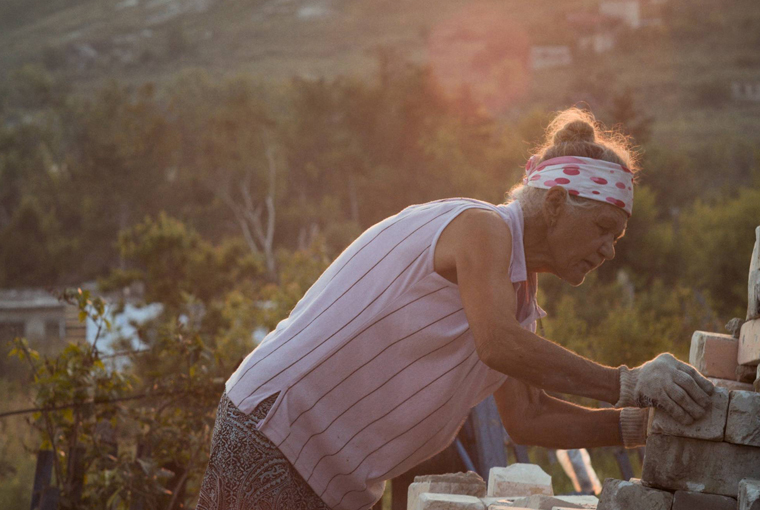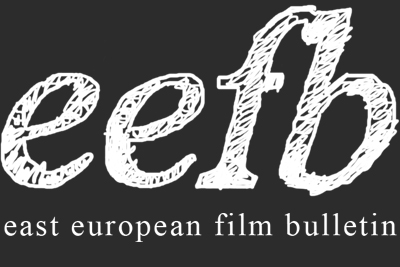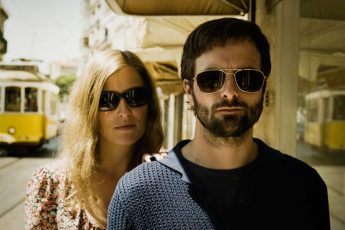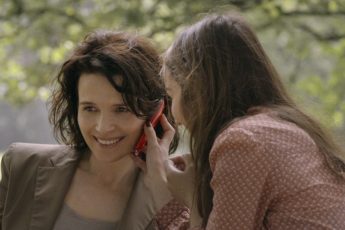
In times of war, life begins with a funeral. Sergei Loznitsa’s The Invasion (2024) is a 145-minute chronicle of everyday life in Ukraine under Russian attack. Loznitsa has assembled the film from dozens of short films shot over two years after Russia’s full-scale invasion of Ukraine in February 2022. Only alluding to the violent disaster at the front lines, his film zooms onto the remnants of “normal” life in a country under permanent attack. With the war moving on at a relentless pace, the world documented in The Invasion has already become history.
The Invasion opens with a slow 15-minute prelude of a funeral for soldiers killed in combat. Reminiscent of Loznitsa’s archival documentary State Funeral (2019), burial scenes also structure his latest film. Where State Funeral captures the hysterical and pompous mass mourning after Stalin’s death, the three funerals in The Invasion are bitterly real. The opening scene focuses on people who have been to hell and back, with the war sending shock waves through the entire population.
Among the mourning crowd are men in military clothing holding framed photographs of their dead comrades. Their faces are filled with disbelief and sorrow. After the funeral, injured soldiers leave the church limping, when an air alert disrupts their procession. Undeterred, the mourners keep singing: “We will be born at night / in the spring dew.” One man raises his hand holding up red flowers to the sky, an image of defiant resistance. A close-up on his shaky hand is followed by a shot of the collective chant “Glory to Ukraine!”
While the opening funeral is orchestral, other ceremonies are more intimate in atmosphere. Like musical interludes, the funeral scenes speak to each other across the film like variations on a theme. One of the most harrowing moments in The Invasion is the funeral of twenty-one-year-old Ostap who died during his third service at the front line. Addressing his grief-struck family and friends, the priest recalls baptizing him as a boy. Overflowing with sadness, the ceremony is impossible to watch without crying.
The viewer is both close to and detached from what is happening on screen. Loznitsa edited the film from abroad together with Danielius Kokanauskis. He had a small crew on the ground, collecting dozens of vignettes across the country. Each episode dictated the next, a seriality that gets dissolved in the film’s cyclical journey through the seasons, from snowy roads into hazy midsummer. The film has its own rhythm, with episodes taking up threads from previous ones.
The film is non-linear yet does not flow. In her essay on Homer’s Iliad, published in 1943, the Ukrainian-French philosopher and choreographer Rachel Bespaloff described the temporality of war as a series of fleeting moments with the eternity of a nightmare.1 Trauma makes the most ephemeral moments eternal. The Invasion similarly plays with time, stretching out minute details as if to save them from passing. There are few cuts; moments appear like memories or a dream.
Evgeny Adamenko and Piotr Pawlus’ camera is always static, producing an observing gaze that makes do without movement: “I did not want to have any interviews,” Loznitsa explains, “just observation.” The result of this method, similar to his archival films, is an almost neutral gaze that leaves space to the viewers to draw their own conclusions. This gaze from nowhere, however, also creates a certain distance between viewer, director, and the Ukrainian suffering as it unfolds.
Shot a decade after Maidan (2014), The Invasion mirrors Loznitsa’s complicated relationship with Ukrainian politics. A Dutch-French-US co-production that premiered at Cannes, The Invasion was banned from festivals in his homeland. Expelled in 2022 from the Ukrainian Film Academy for “cosmopolitanism,” Loznitsa remains controversial for his critical positions. Faced with the reproach of betraying the Ukrainian nation, he has countered: “I have always been and will remain a Ukrainian filmmaker. I hope that all of us will keep our common sense in this tragic time.”2 This sentiment pulses through The Invasion, which does not hold back its criticism of cultural and memory politics in contemporary Ukraine.
One of the most striking scenes documents how Russian books are collected and pulped en masse. Another shot shows a damaged Pushkin monument spray painted with “murderer.” Recycling books is not exactly like fascist book burning, but Loznitsa lets the ambiguity hang in the air. The camera arrests on a half-destroyed Russian book about World War II, titled “The Furnaces of 1941,” which gets stuck in the paper machine.
Loznitsa arranges the book scene into a not-so-subtle criticism of censorship. The books turned into paper shreds are not just works of Russian literature, ranging from authors such as Mayakovsky to the Strugatsky brothers, but also everything translated into Russian, Jack London, Mark Twain, a book about Loch Ness, Stefan Zweig. The pulp’s conveyor belt echoes the human meat grinder of the Russian war machine. Without any transition, the next episode is a shooting exercise where a young woman is trained in target practice.
In The Invasion, life prevails over death. One tender moment follows a soldier who visits his partner and their newborn son in hospital. Still in uniform, he puts drops into his son’s blocked nose: “You are my hero!” It is such instants of defiant love and care that Loznitsa’s cinematic archive seeks to immortalize. Among the many funerals, there is a bittersweet wedding scene that has the groom dancing in his army uniform. His bride cries through the ceremony: “May your eyes always shine as they do today and if there are tears may they be tears of happiness.” When her loved ones hug her, the groom asks: “What about me?”
It is those precious moments of life that the Russian army tears apart every day. The film is set in ruins, deserted villages, bombed-out houses, and rubble covered in snow. We look into the kitchen of an apartment bloc torn apart by shelling that resembles a miniature model. The heart of The Invasion is an ice swimming scene connected to the celebration of Epiphany that has been widely practiced in Ukraine since the post-Soviet revival of Orthodox Christianity. Evoking the baptism of Jesus, the swimmers make the sign of the cross before they dip until an air raid warning starts to howl. An announcement alerts the swimmers to take shelter in a street named after the “Stalingrad heroes.”
Each shot has a different angle on civilian resilience and survival amidst the unfolding tragedy. A school class has moved underground, continuing their lessons in the basement. The kids eat on the floor, the dark room lit up by their smartphones. The most explicitly violent scene is an aerial shot of a bombed-out bloc, with emergency workers searching the rubble for survivors. It looks like a news reel that has already become all too familiar, paired by the director with the image of a grave adorned with children’s toys. In other words, the scene feels trite.
What are we left with after watching the film? Not very much. Of course, the footage of people’s lives under those tragic circumstances is emotionally moving – nobody can be left cold by the suffering we see – but The Invasion is not a powerful movie. The director’s attempt at surgical observation, a view from nowhere, results in two-and-a-half hours of what looks like late-night TV newsreels. Viewers might disengage or just change the channel. What seemed an effective strategy in his archival movies – to simply let the material speak for itself, without commentary – seems less successful or even appropriate when it comes to people’s lives in today’s war-torn Ukraine. We need films that do more and say more.
Detached observation is impossible; every camera is held by a hand. What do the kids see when they sit in the basement of their school? What does the ice swimmer do in the split second of silence before the air raid? And whose hands lift the books onto the conveyor belt? People are not just footage to be assembled on the editing table by a disengaged surgeon. Every war is defined by the media of its time. In an era where ten seconds of raw footage can grab the world’s attention, a sterile exercise in editing fails to cut through the deluge of images that has shaped the current war. In Loznitsa’s cinematic operation theater, the scalpel does not cut very deep.
- Bespaloff, Rachel (2005). “On the Iliad”. In: Simone Weil & Rachel Bespaloff (eds.). War and the Iliad. New York: NYRB Classics, 39–100. ↩︎
- “Open letter from Sergei Loznitsa”. e-flux. https://www.e-flux.com/announcements/456683/open-letter-from-sergei-loznitsa-on-his-expulsion-from-the-ukrainian-film-academy/ [Accessed on 14 February 2025]. ↩︎




Leave a Comment